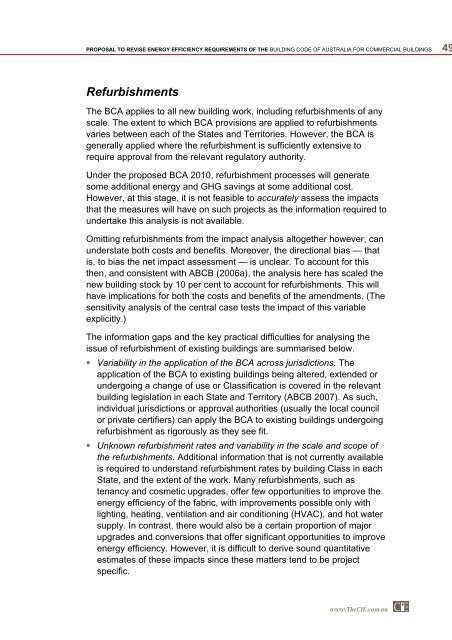PDF | 2 MB - Australian Building Codes Board
PDF | 2 MB - Australian Building Codes Board
PDF | 2 MB - Australian Building Codes Board
You also want an ePaper? Increase the reach of your titles
YUMPU automatically turns print PDFs into web optimized ePapers that Google loves.
PROPOSAL TO REVISE ENERGY EFFICIENCY REQUIREMENTS OF THE BUILDING CODE OF AUSTRALIA FOR COMMERCIAL BUILDINGS 49<br />
Refurbishments<br />
The BCA applies to all new building work, including refurbishments of any<br />
scale. The extent to which BCA provisions are applied to refurbishments<br />
varies between each of the States and Territories. However, the BCA is<br />
generally applied where the refurbishment is sufficiently extensive to<br />
require approval from the relevant regulatory authority.<br />
Under the proposed BCA 2010, refurbishment processes will generate<br />
some additional energy and GHG savings at some additional cost.<br />
However, at this stage, it is not feasible to accurately assess the impacts<br />
that the measures will have on such projects as the information required to<br />
undertake this analysis is not available.<br />
Omitting refurbishments from the impact analysis altogether however, can<br />
understate both costs and benefits. Moreover, the directional bias — that<br />
is, to bias the net impact assessment — is unclear. To account for this<br />
then, and consistent with ABCB (2006a), the analysis here has scaled the<br />
new building stock by 10 per cent to account for refurbishments. This will<br />
have implications for both the costs and benefits of the amendments. (The<br />
sensitivity analysis of the central case tests the impact of this variable<br />
explicitly.)<br />
The information gaps and the key practical difficulties for analysing the<br />
issue of refurbishment of existing buildings are summarised below.<br />
• Variability in the application of the BCA across jurisdictions. The<br />
application of the BCA to existing buildings being altered, extended or<br />
undergoing a change of use or Classification is covered in the relevant<br />
building legislation in each State and Territory (ABCB 2007). As such,<br />
individual jurisdictions or approval authorities (usually the local council<br />
or private certifiers) can apply the BCA to existing buildings undergoing<br />
refurbishment as rigorously as they see fit.<br />
• Unknown refurbishment rates and variability in the scale and scope of<br />
the refurbishments. Additional information that is not currently available<br />
is required to understand refurbishment rates by building Class in each<br />
State, and the extent of the work. Many refurbishments, such as<br />
tenancy and cosmetic upgrades, offer few opportunities to improve the<br />
energy efficiency of the fabric, with improvements possible only with<br />
lighting, heating, ventilation and air conditioning (HVAC), and hot water<br />
supply. In contrast, there would also be a certain proportion of major<br />
upgrades and conversions that offer significant opportunities to improve<br />
energy efficiency. However, it is difficult to derive sound quantitative<br />
estimates of these impacts since these matters tend to be project<br />
specific.<br />
www.TheCIE.com.au
















